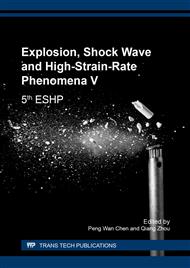p.123
p.130
p.137
p.143
p.149
p.155
p.161
p.169
p.176
Dynamic Response Analysis of Mortar Block under Blast Loading Using Digital Image Correlation
Abstract:
The dynamic strain distribution behavior of a mortar block blasting was experimentally investigated. A small-scale blasting experiment using a mortar block with well-defined property was conducted and the dynamic strain distribution on the mortal block surface was analyzed using a Digital Image Correlation (DIC) method to establish the effective method for investigating the relationship between blast design and fracture mechanism. The block was blasted by simultaneous detonation of Composition C4 explosive charges with an electric detonator in two boreholes. The behavior of the block surface was observed by two high-speed cameras for three-dimensional DIC analysis and it was also measured by a strain-gauge for comparison. The three-dimensional displacements of the free surface of the block were obtained and dynamic strain distributions were computed. A point strain profile extracted from the analyzed strain distribution data was compared with a directly observed strain profile by the strain gauge.
Info:
Periodical:
Pages:
161-166
Citation:
Online since:
January 2018
Authors:
Price:
Сopyright:
© 2018 Trans Tech Publications Ltd. All Rights Reserved
Share:
Citation:


